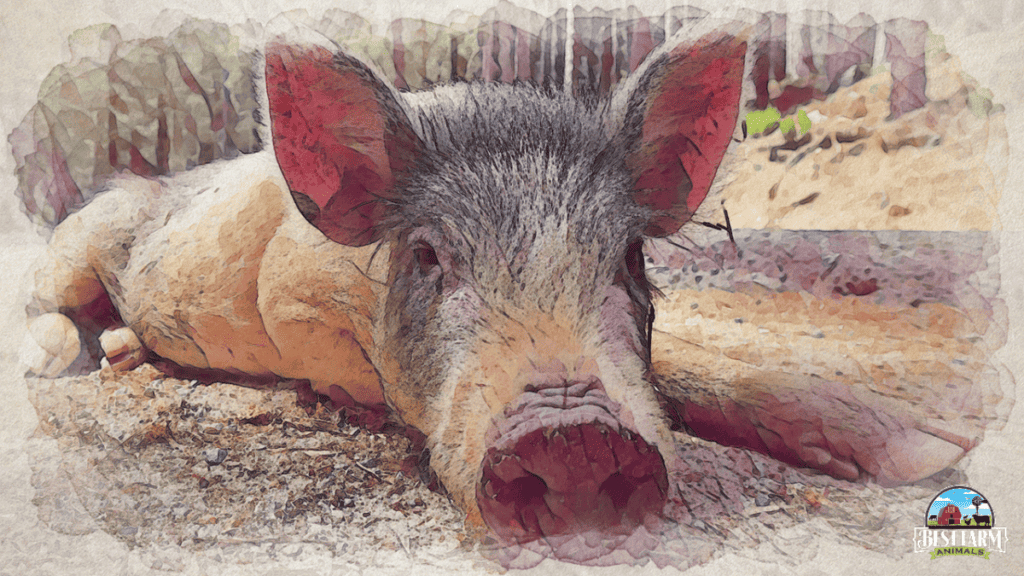It’s heartbreaking to suddenly hear your pig squealing from pain, being unable to walk while dragging their back legs behind them. Dippity pig syndrome (also known as bleeding back syndrome) is an awful skin condition that young pigs develop along their backs and hind quarters.
Pigs with Dippity Pig Syndrome usually squeal frantically and have difficulty walking without falling down. They struggle with their rear end working and often arch the back. Evidence suggests that this syndrome may be hereditary in pigs. Factors like sunburn, stress, and even loud claps of thunder can bring this condition on.
Signs of Dippity Pig Syndrome
Dippity pig symptoms will appear suddenly, usually with weeping sores on their sides or back while pigs with Teschen disease won’t have sores. These blisters can form in a matter of minutes. The pig will be unsteady on their feet, with legs that move like rubber, and the pig will ‘dip’ down onto the ground. Your pig may scream out in pain and drag their back legs.
Treating Dippity Pig Syndrome
The best thing you can do for your pigs is reduce their stress. Playing soft music will help them relax. Ensure they are always well hydrated. Keep your pig comfortable. Hydrocortisone creams prescribed by your vet will also help alleviate the pain when applied twice daily (or according to your vet’s instructions).
Luckily this syndrome only lasts a couple of days (two to four days max) and should resolve without too much intervention. Even so, it’s still a painful and traumatic experience for your pig.
Dippity Pig Is Scary For Pig Owners
Dippity Pig is one of the scariest experiences that I’ve ever witnessed. A young pig suddenly can’t walk and appears to be bleeding out of large gashes in it’s back. The pig is obviously in pain as his hindquarters seem to be made of Jell-O.
I hope this has never happened to you, but it got me wondering so I did a lot of research and talked to a couple of professionals to find out what’s happening.
Is Dippity Pig a Virus? Dippity Pig is classified as a virus and thought to be a virus, but the exact virus hasn’t been identified. Some studies have suggested that it’s similar to the herpes virus in humans that causes shingles. Scientists are attempting to identify exactly what causes Dippity Pig.
Unfortunately, Dippity is one of those illnesses which we know far too little about. However, there do seem to be several commonalities across the cases help scientists and vets with the illness.

Dippity Pig Syndrome
Dippity pig syndrome, also known as bleeding back syndrome, is a horrible disease for pigs to contract. Sunburn and sudden loud noises such as thunder can bring on flare-ups of this condition.
This skin condition develops along a pig’s hindquarters and back, creating painful sores that weep pus and blood. This awful disease also causes weakness in your pig’s back legs. According to research, this disease is hereditary and typically affects younger pigs.
This syndrome gets its name because an infected pig has a temporary loss of use of its hind legs and has to make a “dipping” motion to move. Interestingly, the syndrome does not affect the front legs.
Is Dippity Pig Hereditary? Dippity Pig Syndrome may be hereditary in certain pig breeds.While any pig breed or age can be susceptible to this condition, it appears to be more prevalent in certain genetic lines.
Overall, the evidence suggests that there may be a hereditary component to Dippity Pig Syndrome, although further research is needed to fully understand the genetics behind this condition.
It appears to be exacerbated by stress factors. Sunburnds, a trip to the vet, a pig show, new owner, thunderstorms or a change in routine may bring it on.
Does Dippity Pig Syndrome Go Away?
Dippity Pig Syndrome typically goes away in two to four days. Sometimes it goes away within 24 hours. There is currently no cure for it, but it can be managed with anti-inflammatory medicine. It often comes on spontaneously and goes away just as mysteriously.
Spring and summer are the most common times of the year for it to appear.
How Long Does Dippity Pig Syndrome Last? Dippity Pig usually lasts for between one and three days. It resolves itself on its own, but that usually isn’t a comfort to pig owners. To make matters worse, stress usually brings it on.
That’s one of the things that makes Dippity harder for owners to deal with- they might be in the middle of a pig show or a vet visit- exactly the time they don’t want to deal with Dippity.
Can a pig die from dippity pig syndrome? Pigs cannot die of Dippity Pig, although there are other diseases with similar symptoms that can be deadly. Misdiagnosing an illness as Dippity can be deadly for your pig.
Fortunately, DIppity Pig doesn’t appear to be contagious. There are no known cases of Dippity spreading from pig to pig or infecting an entire herd. Instead, the disease seems to strike an individual pig spontaneously. It seldom strikes older pigs nor does it strike the same pig twice.
Symptoms of Dippity Pig
Dippity Pig Syndrome has horrible symptoms such as sudden aggression and loss of weight. Your pig will start developing sores on their backs and sides, further aggravating the itchiness.
You may find that your pig moans and squeals. This syndrome causes a lot of pain and discomfort, which makes your pig unsteady on their feet and not want to eat.
Unfortunately, the pain and itchiness can drive your pig into a panic. Calm your pig down by talking softly to them and playing soothing music.
- Sores on their back and sides
- Squealing and moaning from pain
- Itchiness and scratching
- Unsteady on their feet
- Loss of appetite
- Loss of weight
- Sudden aggression as a result of the pain
Dippity Pig Treatment
Follow these steps to treat the effects of Dippity Pig syndrome:
Topical hydrocortisone creams (prescribed by a vet) can be applied to your pig’s skin to alleviate the itchiness and pain. Keep your pig well-hydrated and as comfortable as possible. Ease stress from scratching by playing soothing music and keeping your pig as calm as possible.
The symptoms should ease up within two to four days.
- Most importantly, you need to calm your pig down. The pain and itchiness from this syndrome cause them to panic. Reduce their stress by playing soft and soothing music.
- Apply topical hydrocortisone creams to the infected areas to alleviate the pain and itchiness. Your vet will need to prescribe this medication, as you can’t buy it without a prescription.
- Ensure your pig is hydrated and comfortable. Fortunately, this syndrome will only last a couple of days (two to four days).
Dippity Pig FAQs
Can Humans Get Dippity Pig Syndrome? Humans cannot get Dippity Pig Syndrome. Even so, it’s a good idea always to handle your pig with proper cleanliness habits and make sure you wash your hands and clothes after handling an ill pig.
How Do You Get Rid of Dippity Pig Syndrome? Unfortunately, there aren’t medicines that will cure a pig of Dippity Pig Syndrome, but pigs do get better within a few days. You’ll have to wait for your pig to get better, but you can help by reducing stress factors on the pig such as a change of routine or being separated from its buddies.
Conclusion
Dippity pig syndrome is not fatal and although inconvenient, will only last a few days.
If, instead of a sudden onset of lameness, your pig seems to develop a slower progression of limping and lameness, your pig may be suffering from pig arthritis.
References
MDPIcom
Virological Characterization of Pigs with Erythema Multiforme
My Most Used Pig Supplies
This list contains affiliate products. Affiliate products do not cost more but helps to support BestFarmAnimals and our goal to provide farm animal owners with accurate and helpful information.
Purina Pig Chow will last well (or Mazuri is popular, but I haven’t tried it), and the stainless steel non-skid bowls that will help keep the mess down.
A pig blanket to keep her warm. This one also has bright colors and helps to provide rooting without the destruction.
Pig Harness for walking and handling your pig. There are a lot to choose from, but this one is pretty easy to use. If you want one that has a separate leash, this looks like a good one.
A large crate for keeping her safe in your house at night and when you leave the house. This is essential. You’ll also want a litterbox, and I like mine with a lid for nighttime. Pine shavings are best, and you may be able to find them in larger quantities locally.
When you have accidents, Odoban will help eliminate odors. When you are potty training, these floor pads work great for keeping your house clean while training her to go in certain places.
You’ll also want an outdoor house to keep her warm when she gets outside time, an essential part of her development.
Dewormer- Ivermectin is the primary dewormer I use, although I do rotate with a non-ivermect ingredient once so that the worms don’t get immune to it.

